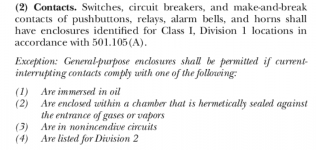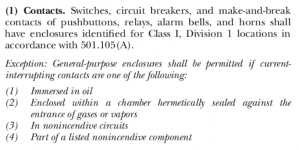chrisplusian
Member
- Location
- Orange Park, FL
- Occupation
- Automation Systems Engineer
I am dealing with a design which will have all C1D2 rated pneumatic valve assemblies (actuated via a relay controlled solenoid located on top of the valve) in a C1D2 area in one enclosure, and a second enclosure which will have controls equipment all rated C1D2. I am trying to understand if all the equipment located inside the enclosure is C1D2 does the enclosure need to be purged and pressurized because of the power feed to the panel?
500.8(B)(3) gives provisions for a non-explosion proof enclosure, and 501.10(B)(4) agrees. There is an issue I don't understand and that is 501.10(B)(4) points to 501.105(B)(2) as well as 501.150(B)(1). Both of the later sections deal with:
Switches, circuit breakers, and make-and-break
contacts of pushbuttons, relays, alarm bells, and horns shall
have enclosures identifed for Class I, Division 1 locations in
accordance with 501.105(A)
But the exceptions are different. 501.105(B)(2) exception allows things listed for division 2 locations, while 501.150)(B)(1) does not. Confusing is that 501.105 is for "Meters, Instruments, and Relays" while 501.150 is for "Signaling, alarm, Remote-Control, and Communications". Oddly enough I typically consider alarm bells, and horns to fall in the category of signaling or alarm, and relays to fall into the category of remote-control. I have always been able to place my panels outside the Hazardous areas in the past, so this is the first time panels will have to go in a Class 1 Divsion 2 location. I thought the panel would need to be purged and pressurized because it has a 10 amp feed coming into the enclosure by means of TC-ER-HL cable. I realize that 500.8(B)(3) uses the word normal which is not defined in the NEC.
I have two questions I seek to answer in general:
1) Does a panel which only contains equipment rated for class 1 division 2 locations not have to be purged and pressurized or explosion proof when the branch circuit feeding it is rated 10A @120VAC, or 10A @24VDC (obviously not IS or NI)?
2) Why does 501.105(B)(2) allow for division 2 equipment in the exception and 501.150(B)(1) does not?
500.8(B)(3) gives provisions for a non-explosion proof enclosure, and 501.10(B)(4) agrees. There is an issue I don't understand and that is 501.10(B)(4) points to 501.105(B)(2) as well as 501.150(B)(1). Both of the later sections deal with:
Switches, circuit breakers, and make-and-break
contacts of pushbuttons, relays, alarm bells, and horns shall
have enclosures identifed for Class I, Division 1 locations in
accordance with 501.105(A)
But the exceptions are different. 501.105(B)(2) exception allows things listed for division 2 locations, while 501.150)(B)(1) does not. Confusing is that 501.105 is for "Meters, Instruments, and Relays" while 501.150 is for "Signaling, alarm, Remote-Control, and Communications". Oddly enough I typically consider alarm bells, and horns to fall in the category of signaling or alarm, and relays to fall into the category of remote-control. I have always been able to place my panels outside the Hazardous areas in the past, so this is the first time panels will have to go in a Class 1 Divsion 2 location. I thought the panel would need to be purged and pressurized because it has a 10 amp feed coming into the enclosure by means of TC-ER-HL cable. I realize that 500.8(B)(3) uses the word normal which is not defined in the NEC.
I have two questions I seek to answer in general:
1) Does a panel which only contains equipment rated for class 1 division 2 locations not have to be purged and pressurized or explosion proof when the branch circuit feeding it is rated 10A @120VAC, or 10A @24VDC (obviously not IS or NI)?
2) Why does 501.105(B)(2) allow for division 2 equipment in the exception and 501.150(B)(1) does not?


